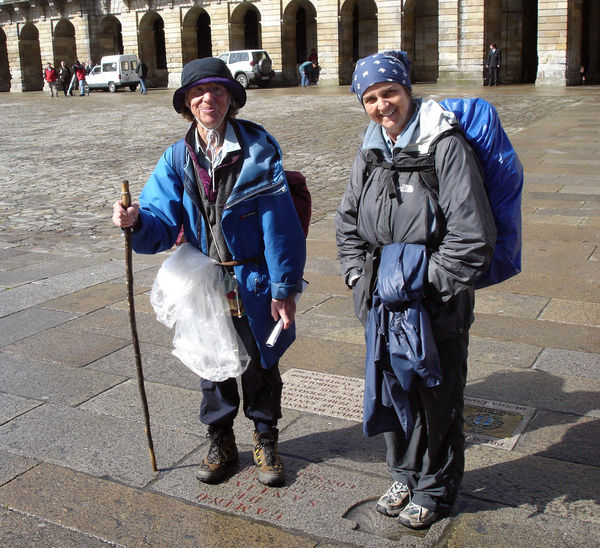A Medieval Pilgrimage in Modern Times
By Rick Steves
Standing on the main square of Santiago de Compostela, I share the joy of pilgrims who've completed the Camino de Santiago (Spanish for "Way of St. James"). With sunburned faces and frayed walking sticks, they triumphantly end their long trek by stepping on a scallop shell carved into the pavement in front of the city's magnificent cathedral. For over a thousand years, this cathedral in the far northwest corner of Spain has been the ritualistic last step for pilgrims who've hiked here from churches in Paris and all over Europe. Today, most take a month to walk the 450 miles from the French border town of Saint-Jean-Pied-de-Port.
To enjoy the scene, be on the square about 10 a.m. The last overnight stop on the Camino (or pilgrimage) is two miles away, and most pilgrims arrive at the cathedral in time for the 12:00 Mass. It's great fun to chat with pilgrims who've just completed their journey. They seem very centered, content with the experience, and tuned in to the important things in life...like taking time to talk with others.
James, Santiago's namesake and symbol, was a Christian evangelist — one of Jesus' original "fishers of men." But judging from the way he's portrayed here, his main activity was beheading Muslims with his busy sword. Propagandistic statues of James are all over town — riding in from heaven to help the Spaniards defeat the Muslim Moors.
Police guard the square. Security here has been tight ever since September 11, 2001 — and even more so since March 11, 2004, when Madrid's commuter trains were bombed. Santiago's cathedral, as one of the leading pilgrimage sites in Christendom, is a high-profile target for Islamic fundamentalists. It doesn't help that St. James is depicted taking such joy in butchering Muslims.
Historians figure the "discovery" of the remains of St. James in Spain was a medieval hoax. It was designed to rally Europe against the Muslim Moors, who had invaded Spain and were threatening to continue into Europe. With St. James — a.k.a. "the Moor Slayer" — buried in Iberia, all of Europe would rise up to push the Muslims back into Africa...which, after a centuries-long "Reconquista," they finally did in 1492.
All this commotion dates back about 1,200 years to a monk who followed a field of stars (probably the Milky Way) to this distant corner of Europe and discovered what appeared to be the long-lost tomb of St. James. Church leaders declared that St. James' relics had been found, built a church, and named the place Santiago (St. James) de Compostela (campo de estrellas, or "field of stars").
Imagine you're a medieval pilgrim. You've just walked from Paris — more than 700 miles — to reach this cathedral. Your goal: to request the help of St. James in recovering from an illness. Or maybe you've come to honor the wish of a dying relative...or to be forgiven for your sins. Whatever the reason, you know the pope promised that any person who walked to Santiago in a Holy Year, confessed their sins, and took communion here would be forgiven.
After weeks of hiking, the spire of the cathedral comes into view and jubilation quickens your tired pace. Finally you stand upon the shell in the pavement and gaze up at the awe-inspiring cathedral. You step inside, squint down the nave, and see the statue of St. James that marks his tomb.
Kneeling at the silver tomb of St. James, you pray and make your request. Then you climb the stairs behind the altar up to the saint's much-venerated statue — gilded and caked with precious gems — and wait your turn to embrace him from behind while gazing thankfully out over the cathedral. You have completed the Camino de Santiago.
Walking the Way of St. James has changed little over the centuries. The gear still includes a cloak, a floppy hat, a walking stick, a gourd (for drinking from wells), and a scallop shell (symbolizing where you're going).
The walk itself is a kind of hut-hopping. At regular intervals along the route, you'll encounter humble government-subsidized hostels called albergues, where pilgrims can rest for the night (free bunks, though small donation often requested).
Recently the route has enjoyed a huge renaissance of interest, with around 100,000 pilgrims trekking to Santiago these days. Bikers and horse riders are now joining hikers.
Whether you hike the entire route or just the last stretch — or even if you're just there to vicariously enjoy the thrill of the latest in a thousand years of pilgrims finishing the Camino de Santiago — it's an experience that will stay with you forever.

